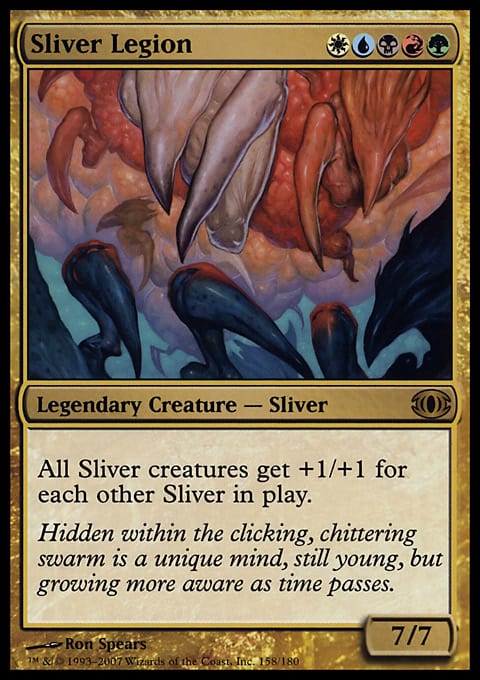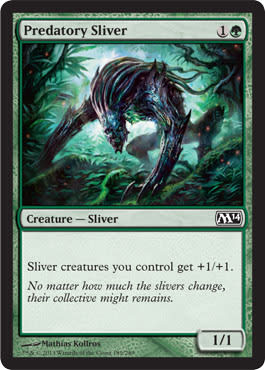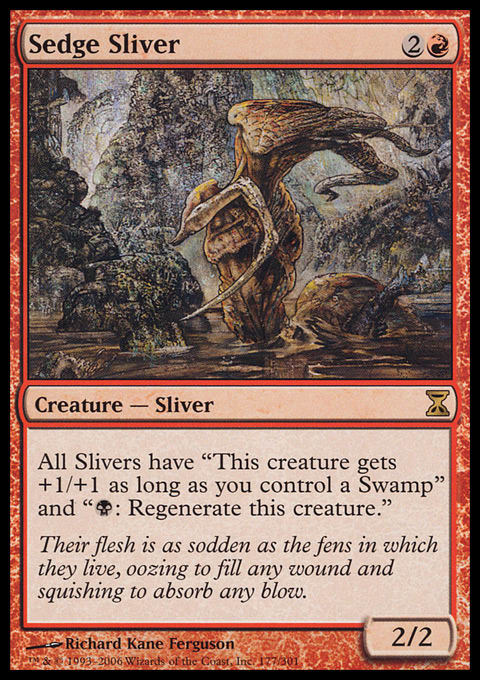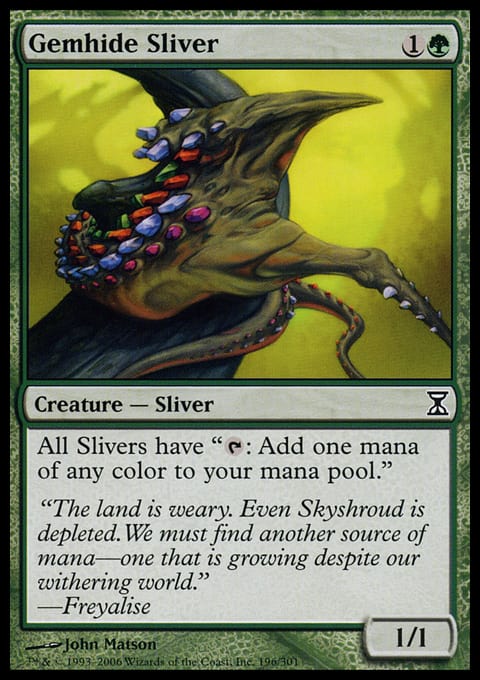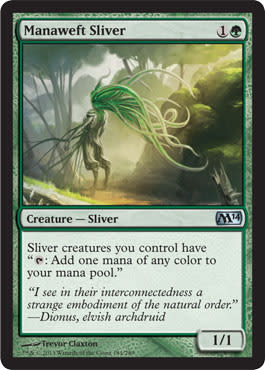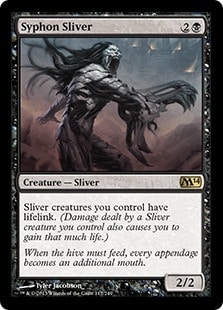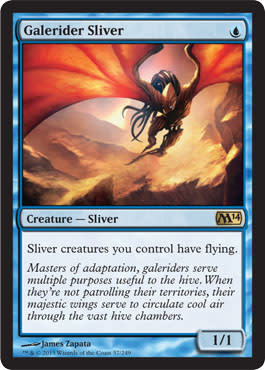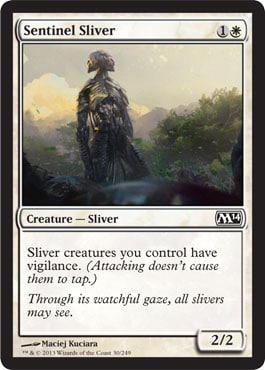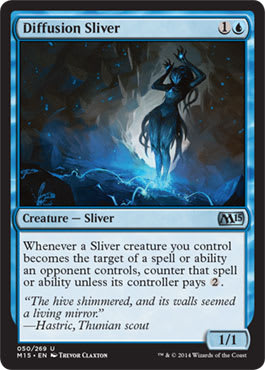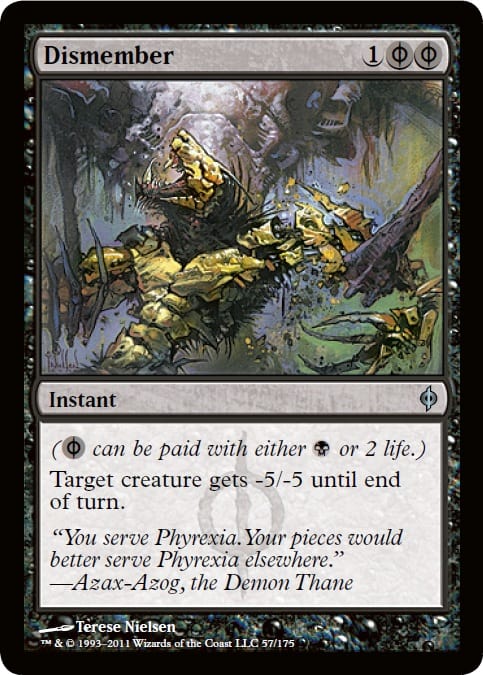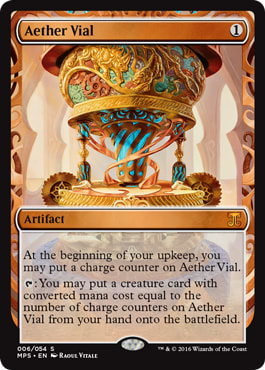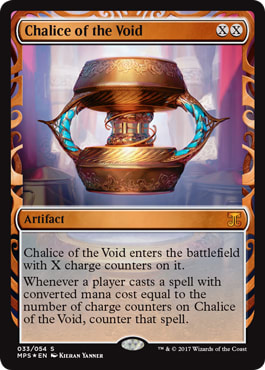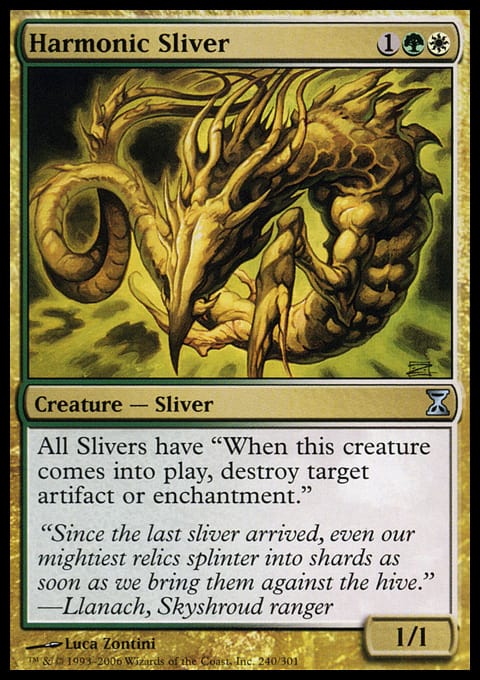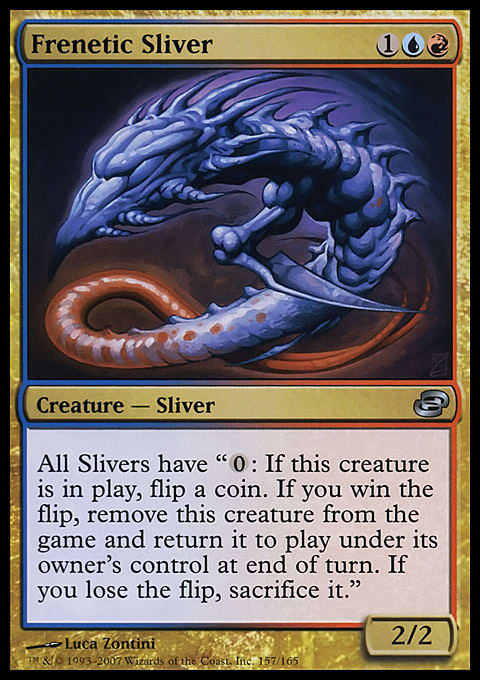
Don’t be alarmed by that slithering, that clicking, that claw tap-tap-tapping on the stone. They rustle, they scurry, and then they swarm. Slivers are each but part of a whole, all fragments of a hive. They mean synergy. And once they share enough sinuous strength, they’re unstoppable. Don’t be alarmed. Be terrified.
Slivers have filled Planeswalkers with dread and glee throughout Magic’s history. They first appeared in 1997 in Tempest, under command of a dark lord. They returned in 2003 in Legions, recreated in a laboratory from fossils, which is how all good rampages start. They snaked out of a reality bubble to join the Time Spiral party in 2006, and their most recent encores came in Magic 2014 and Magic 2015. In Commander, they are infamous. In Legacy, comprise are a fringe deck. Now, thanks to the printing of Collected Company, they are the most resilient tribal strategy in Modern.
Slivers ? Modern | A.E. Marling
- Creatures (30)
- 1 Manaweft Sliver
- 1 Necrotic Sliver
- 1 Syphon Sliver
- 2 Blur Sliver
- 2 Striking Sliver
- 3 Gemhide Sliver
- 4 Diffusion Sliver
- 4 Galerider Sliver
- 4 Predatory Sliver
- 4 Sedge Sliver
- 4 Sinew Sliver
- Spells (9)
- 2 Dismember
- 4 Collected Company
- 3 Aether Vial
- Lands (21)
- 1 Forest
- 1 Swamp
- 1 Blood Crypt
- 1 Breeding Pool
- 1 Godless Shrine
- 2 Mutavault
- 2 Overgrown Tomb
- 4 Cavern of Souls
- 4 Sliver Hive
- 4 Verdant Catacombs
I won my StarCityGames States tournament with Slivers. I chose the deck for hilarity, the nostalgia, and the novelty. Other players loved seeing the deck, sometimes even as I overran them. I gained an edge by bewildering my opponents. By reading this primer, you can better prepare yourself against this ancient tribal strategy—or learn the basics of unleashing your own alien infestation.
Hive Components
The Lords
Unlike Merfolk lords, Slivers grant their abilities even to themselves. Slivers with old templating are generous enough to boost the opponent’s Mutavaults as well. The Slivers most often referred to as lords add power and toughness. These hivemates have the most overt power. Imagine a modest board position of two Slivers in play. Casting Collected Company and hitting two of these lords means adding 10 power to the living avalanche. And some Slivers grant even greater power.
The Time Spiral Slivers all referenced earlier cards, and this one stretches back to Alpha’s Sedge Troll. With regenerative blood flowing through the Slivers’ veins, they can withstand Lightning Bolt and Abrupt Decay. Even without a Swamp in play, a Sliver can save another one by tapping for black mana.
The Mana Slivers
Gemhide Sliver is the strictly better card, based on art. The deck wants at least four of these total. They transform 1-drop Slivers into Birds of Paradise that will attack for 3 to 5 damage on the kill turn. They accelerate into Collected Company, and they lead to a chain reaction of Sliver production with Blur Sliver.
Like the hasty Sliver, the effects of the mana Slivers don’t stack. In multiples, they disappoint. Their power has to be weighed against the weakness of their redundancy. This is true also of Syphon Sliver and Necrotic Sliver as well as a few surprising strains in the sideboard.
Non-Stacking Slivers
Necrotic Sliver embodies the card Vindicate, but it plays out more like Desert Twister. The effect is powerful, but slow. Remember that any Sliver can be sacrificed, not just the Necrotic one. I used this to erode my opponent’s Tron lands in the Top 8, but even blowing up a Tarmogoyf in response to targeted removal is powerful. The reason I only played one is that it’s worthless in races, such as against Burn. Then, I wanted quick, sleek Slivers.
As Slivers share abilities equally, 1-drops gain the most for their mana cost. More than that, these Slivers are almost free, as they fit in the curve turn one or off the first counter on Aether Vial. The Galerider Sliver is one of the chief reasons to play the deck, as the evasion helps not only on aggression, but also to block Affinity’s flying machinery.
Because Galerider Sliver grants a more powerful effect, the deck plays more copies compared to Striking Sliver (four to two). Some Sliver lists played zero Striking Slivers. I hail Adam Bowman for guiding the hooked throng back into prominence with his SCG Open Top 8. This Sliver vindicator played Sentinel Sliver instead of the first-striker.
Of all the Slivers I didn’t play, this one I’m most excited to discuss. Sentinel Sliver combined with a mana Sliver allows a thriving throng to attack with mana open for regeneration, casting post-combat slivers, or adding a new swarmling with Sliver Hive—not to mention the opportunity to block. Sometimes when cast, Sentinel Sliver will feel like the strongest Sliver in the deck. I still decided against it.
I see this card as a win-more. It is powerful in games in which three or more Slivers have amassed on the board. In more meager times, with but two Slivers, Striking Sliver’s first strike allows for more combat victories without taking losses. Slivers rarely wish to trade, as each survivor gains strength relative to the opponent’s creatures as the game progresses.
Those times when Sentinel Sliver combines well with a Gemhide Sliver, a Striking Sliver could’ve been there a turn earlier, adding mana sooner. It blocks faster, and often, the Sliver horde doesn’t need to attack and defend at the same time. It’s happy staying back until it amasses enough claw-power to kill the opponent in one swoop, thanks to all the lords. The deck has a glut of 2-mana spells, and I chose not to cut a lord for a Sentinel Sliver.
Feel free to disagree. Slivers is a new archetype in Modern, and we will hone the list over the upcoming months and years. The choices I made in my Sliver selection and mana base reflect concerns over worst-case scenarios. I sacrificed top power for base consistency. I credit my curve considerations to Frank Karsten’s Slivers list. He did play Sentinel Sliver, but I put a higher premium something more slippery.
The Skill Tester
This is my favorite Sliver in the deck and my preferred turn-two play. If the opponent wishes to thwart the developing Sliver mob, he or she must kill Diffusion Sliver first. If he or she Lightning Bolts it, you gain tempo, as it costs that opponent 3 mana to kill your 2-mana spell. The best Modern removal becomes as bad as Carbonize. Electrolyze and Kolaghan's Command cost 5, as would a flashed-back Bolt off Snapcaster Mage. If the opponent doesn’t have the mana, he or she can die with a hand full of removal. Only Abrupt Decay trades evenly with Diffusion Sliver, but at the worst, it draws fire from your other lords.
At best, the opponent forgets about it, and I crush him or her with an onboard trick. Each time a Sliver is targeted, say by a Pestermite, the Sliver player must put the Diffusion trigger on the stack. And multiple Diffusion Slivers add up. I thwarted even the legendary appetite of Ulamog, the Ceaseless Hunger. Exiling two creatures would’ve cost 8 additional mana since I had two Diffusion Slivers.
A less stellar moment during my tournament was when I failed to preempt with Diffusion Sliver. Like Kira, Great Glass-Spinner, Diffusion Sliver must be in play before the effect or spell is put on the stack. If Lightning Bolt is already aiming at a Syphon Sliver, concocting a Diffusion Sliver at instant speed off an Aether Vial won’t help. In the tournament, I allowed my opponent to block with his Fulminator Mage then sac to kill my Mutavault. Had I held priority after attacks and tapped the Mutavault to activate itself first, he would’ve had to target another of my lands.
The Non-Slivers
Dismember adds another 1-mana spell to the curve and gives the deck more play against Twin. What could be more suitable than the hive ripping out the entrails of a Deceiver Exarch? Slivers tend to devour the opponent by the fourth turn, and the slithery strategy fears decks that can end the game on turn three. Dismember can buy the needed time.
As powerful as removal is, the archetype doesn’t want noncreature spells that dilute Collected Company. This 4-drop is the payoff spell. It grants card advantage and allows Slivers to evade board wipes by being cast at the end of the opponent’s turn. The same is true of Aether Vial. But since it can’t cast the green instant, I decided to play only three of the artifact. That could be wrong. I can say only that Aether Vial has diminishing returns. Make that plummeting returns, and the fourth one isn’t as good as the fourth Gemhide Sliver. That much I’ve tested.
A hand with Aether Vial and one land may be a keep, but it probably won’t win unless the second land is drawn by turn two. I would say playing twenty-two lands is more correct than playing twenty. Cavern of Souls and Sliver Hive make the mana base both robust to the snaky tribe and hostile to noncreature spells. The rest of the lands are designed to support Sedge Sliver’s lust for swampland as well as Gemhide Sliver and Collected Company’s need for green.
Mutavault is a giant or larger thanks to the tribal effects, but again I chose a more conservative approach and only played two. Of note, both Mutavault and the tokens from Sliver Hive can block Etched Champion. Also, if the opponent taps down your team with Cryptic Command, let the blue spell resolve and then activate the man lands. I put a 5/5 hasty Sliver token into play that way.
Though Slivers is a five-colored deck, it can’t reliably cast colored non-Sliver spells that aren’t black or green. This matters most in the sideboard.
The ’Board
One delight of playing a new archetype is experimenting with the list. We are mad scientists, breeding new strategies, bewildering our adversaries, making them our living test subjects.
I believe the sideboard could use the most research. When possible, the deck wants to play Slivers. Creatures that cost 3 or less gain additional strength by being searchable through Collected Company. Here’s what I ran at the SCG States.
Slivers ? Modern | A.E. Marling
- Sideboard (15)
- 2 Chalice of the Void
- 1 Darkheart Sliver
- 2 Frenetic Sliver
- 3 Harmonic Sliver
- 2 Syphon Sliver
- 2 Telekinetic Sliver
- 1 Sliver Hivelord
- 2 Thoughtseize
Chalice won me games against Infect (set to 1) and Living End (set to 0). It packs some of the highest raw hate in the format and is particularly strong in Slivers. The hive doesn’t play too many 1-drops, and its creatures can still be forced into play no matter their cost, via Aether Vial or Cavern of Souls. The deck could even set Chalice to 2, which may douse the last spells a Burn deck needed to win. I like it against Amulet Bloom, set to 0 or 1. It might even be good against Affinity on the play (set to 0 or 2). The sideboard could want the third Chalice.
The deck’s other versatile answer is Thoughtseize. It most often replaces Dismember against decks against which I don’t fear their creatures as much as their sweepers. Against creature combo, I’ve been leaving Dismember in and lowering the curve by siding out Collected Company. This could be a mistake.
It’s possible the deck should play more hate that can be found via the Company, such as Spellskite and Hushwing Gryff. I hesitated to include these because of reasons of flavor. (My Level 20 flavor judge certification bleeds into my competitive play.) I wanted my hive pure, but the outsiders may ultimately be correct. When possible, I prefer slivery solutions.
Harmonic Sliver can find the key resonate pitch to break Affinity, and Darkheart Sliver will strike a similar dissonance in Burn players. Against the mechanical legions of robots, one destroy effect won’t be enough. Luckily, they stack. Finding a Harmonic Sliver and a friend off Collected Company will fracture two artifacts. It’s like a build-your-own Creeping Corrosion at instant speed. Casting a second Harmonic Sliver will grant two Shatter triggers. Even so, I fear the matchup. I would like a fourth Harmonic Sliver in the board.
I would also prefer a second Darkheart Sliver. They tend to wriggle into racing matchups where Diffusion Sliver isn’t in demand, such as against Affinity. The sacrifice ability can deny opposing lifelink, and the flexibility of instant-speed life-gain makes it better against Burn than Syphon Sliver. A Skullcrack can more easily nullify lifelink confined to the combat phase. I will be reducing the Syphon Sliver count to one.
Darkheart Sliver also won me a semifinals match against Living End. My life total went to 50, sacrificing my team twice to bring them back in a new age of undeath. Another Sliver that provides defense against this and a wider range of removal is Frenetic Sliver.
In the dark ages of Magic, Frenetic Efreet was the most feared creature in the game. The Efreet’s slivery tribute can surprise the opponent, coming into play at instant speed off Vial or Company and granting the chance to save a creature from Path to Exile, Abrupt Decay, Dismember, or anything. Frenetic Sliver can even lead the charge into the face of looming board wipes. Overextend with confidence.
No other creature tribe in Modern has as much staying power. Despite the randomness of the flip, I value Frenetic Sliver over the more expensive Sliver Hivelord, at least in theory. I’ve never drawn Frenetic Sliver in tournament play because I only built the deck last week and—wee!—this is the wild west of Modern Slivers.
Here’s one I have trouble evaluating. Cube players will know the power of Opposition. Your weakest creature can trump the opponent’s strongest, or mana screw them. I was siding in this Sliver against combo decks, as it has an immediate impact. A Striking Sliver can then tap a Glistener Elf or a Primeval Titan. Your tappers can delay a Twin player’s combo either by denying mana or pinioning the Pestermite that’s being targeted by Splinter Twin.
I can also see Telekinetic Sliver doing too little. Deceiver Exarch can tap down the Sliver that isn’t summoning sick at end of turn. Summer Bloom can lead into Hive Mind for a kill that no number of brainy Slivers can stop. And my plan is to side out Collected Company for these matchups. I don’t want to increase my number of 4-drops against combo decks. However, Collected Company may be the soul of the deck. If it’s never correct to cut the card, Telekinetic Sliver might be wrong. Or the card may be best when the opponent brings in his or her package of Dispel and Negate. Telekinetic Sliver may also be a broader post-’board threat, and perhaps one should come to answer any deck with Tarmogoyf-sized threats.
Only more testing will tell, and nothing could be more fun than cackling while sending experimental hordes into unsuspecting Modern tournaments. Given the voracious data I have so far, the deck is a reasonable contender in the format. Let me know your insights with a comment below or on the MTG Salvation hive forums. The horizon is wide open, and it’s full of Slivers.













